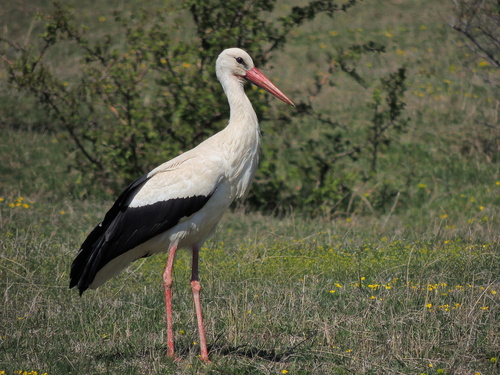
White Stork
The White Stork (Ciconia ciconia) is a large, unmistakable wading bird, renowned for its striking white plumage contrasted by black flight feathers and a vibrant red bill and legs. It holds a significant place in human culture, often symbolizing good luck, prosperity, and new beginnings, particularly in European folklore where it's associated with delivering babies. Ecologically, the White Stork plays a role as a top predator in wetland and agricultural ecosystems, helping to regulate populations of insects, amphibians, and small mammals. Its extensive migrations between Europe and Africa are a remarkable feat of natural navigation.
100-115 cm
Length
155-215 cm
Wingspan
Least Concern
Conservation Status
Distribution
Breeds across Europe, North Africa, the Middle East, and Central Asia. Winters primarily in sub-Saharan Africa, extending to South Africa, and parts of the Indian subcontinent. Migratory routes are well-defined, often following coastlines and utilizing thermal updrafts.
Lifespan
Up to 30 years in the wild, and even longer in captivity.
White Stork's Habitat
Habitat Types
Open grasslands, Agricultural fields, Wetlands, Marshes, Floodplains
Climate Zones
Temperate, Mediterranean, Tropical, Semi-arid
Adaptations
Long legs and a long, pointed bill are well-suited for foraging in shallow water and tall grasses. Their broad wings allow for efficient soaring during long-distance migrations, minimizing energy expenditure.
Variations
Two subspecies are generally recognized: *Ciconia ciconia ciconia* (the European White Stork) and *Ciconia ciconia asiatica* (the Asian White Stork). The Asian subspecies is slightly larger and breeds in Central Asia.
Appearance
Breeding Plumage
Primarily white plumage with black flight feathers (primaries and secondaries). Bill and legs are bright red in adults. Juveniles have a duller bill and legs, often with a blackish tip to the bill.
Seasonal Feather Changes
No significant seasonal variation in plumage color. However, the intensity of the red coloration on the bill and legs can vary, becoming brighter during the breeding season.
Sex Based Plumage Differences
Minimal sexual dimorphism in plumage.
Notable Features
Long, red bill, Long, red legs, Black flight feathers contrasting with white body plumage, Lack of a syrinx (voice box), resulting in bill-clattering as the primary form of communication
Diet and Feeding
Primary Foods
Insects, Amphibians (frogs, toads), Small reptiles (lizards, snakes), Small mammals (rodents, voles), Fish, Earthworms
Foraging Behavior
Typically forages by walking slowly through shallow water or grasslands, visually searching for prey. They will also probe the ground with their bill to locate hidden prey. Often feeds in loose flocks, especially during migration or in areas with abundant food.
Specializations
The long, pointed bill is well-adapted for seizing a variety of prey items. Their long legs allow them to wade in deeper water than many other wading birds.
Seasonal Diet Variations
Diet can vary significantly depending on location and season. During the breeding season, they may consume more amphibians and insects, while in wintering areas, they may rely more on small mammals and fish.
Behavior
Social Structure
Generally gregarious, especially during migration and on wintering grounds, where they can form large flocks. During the breeding season, they are more territorial, defending the area around their nest.
Communication
Bill-clattering (primary form of communication, used in courtship and territorial defense), Hissing (especially by chicks), Low croaking sounds (less common)
Migration
Undertakes long-distance migrations between breeding and wintering grounds. They rely on thermal updrafts to soar and glide, conserving energy. Migration routes are often traditional and passed down through generations.
Territorial or Group Behaviors
Territorial during the breeding season, defending the immediate vicinity of the nest. Outside of the breeding season, they are generally non-territorial and often form large flocks.
Conservation
Threats
Habitat loss (due to agricultural intensification and wetland drainage), Collision with power lines, Pesticide use (affecting prey availability and potentially causing direct poisoning), Climate change (altering migration patterns and breeding success), Hunting (in some parts of their range)
Protection Programs
International agreements (e.g., African-Eurasian Migratory Waterbird Agreement (AEWA)), Habitat restoration and protection projects, Monitoring programs to track population trends, Public awareness campaigns
Local National Laws
Protected under various national and international laws, including the Birds Directive in the European Union.
Population Trend
Stable
Population Estimates
The global population is estimated to be around 500,000-520,000 individuals.
Interesting Facts
White Storks are known to travel vast distances during migration.
Some individuals migrate over 10,000 km (6,200 miles) between their breeding grounds in Europe and their wintering grounds in Africa.
They often build their nests on human-made structures.
This includes rooftops, chimneys, and specially constructed platforms, demonstrating their adaptability to human presence.
White storks lack a voice box.
They communicate primarily through bill-clattering, creating a surprisingly loud and distinctive sound.
They are considered a symbol of good luck in many cultures.
This association likely stems from their return to Europe in spring, coinciding with new life and the planting season.
Faqs about White Stork
Do White Storks mate for life?
White Storks are typically monogamous for a single breeding season, but they may not always pair with the same partner in subsequent years. However, they often return to the same nest site, which increases the likelihood of re-pairing with a previous mate.
What do White Storks eat?
White Storks are opportunistic carnivores, feeding on a wide variety of prey, including insects, amphibians, reptiles, small mammals, fish, and earthworms.
Where do White Storks migrate?
White Storks breeding in Europe typically migrate to sub-Saharan Africa for the winter, while those breeding in Asia may winter in the Indian subcontinent.
Why do White Storks clatter their bills?
Bill-clattering serves as a form of communication, used in courtship displays, territorial defense, and greeting between mates.
Are white storks endangered?
No, White Storks are classified as 'Least Concern' by the IUCN. While they face threats like habitat loss, their overall population is considered stable.
Copyright @ Nature Style Limited. All Rights Reserved.
 English
English